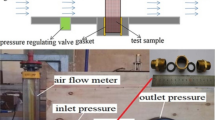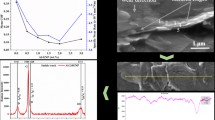Abstract
The use of porous materials as restrictor in aerostatic bearings provides many advantages over conventional restrictors, such as small variation of temperature, high damping, high operational speeds, limited wear and capacity to support radial, axial, and combined loads, being considered important features for precision machines and instruments. This work evaluates the load carrying capacity for different air gaps and pressures of thrust porous bearing made with cementitious composites. The cementitious composites consisted of Portland cement and monomodal silica particles (44 μm) were fabricated via uniaxial cold-pressing (10 MPa). The load capacity was determined for different air pressures, such as 3, 4, 5 and 6 bar. The air gap was measured using pneumatic transducers. A pneumatic instability was observed when the air pressure level increased from 3 to 6 bar. A similar loading capacity, for bearing gaps between 7 and 30 μm, was achieved in comparison to hot-pressed porous alumina found in the literature. In addition, the cementitious porous bearing provided a superior loading capacity for gaps higher than 10 μm when compared to graphite porous bearing found in the literature. The results revealed the cementitious composites are promising materials for porous restrictor in aerostatic thrust bearings.
Similar content being viewed by others
References
Slocum, A. H., “Precision Machine Design,” Society of Manufacturing Engineers, 1992.
Cheng, K. and Rowe, W., “A Selection Strategy for the Design of Externally Pressurized Journal Bearings,” Tribology International, Vol. 28, No. 7, pp. 465–474, 1995.
Kwan, Y. and Corbett, J., “Porous Aerostatic Bearings - An Updated Review,” Wear, Vol. 222, No. 2, pp. 69–73, 1998.
Rubio, J. C. C., “Projeto, construção e avaliação de microposicionadores para usinagem de ultraprecisão,” Ph.D. Thesis, University of São Paulo, 2000.
Schenk, C., Buschmann, S., Risse, S., Eberhardt, R., and Tünnermann, A., “Comparison between Flat Aerostatic Gas-Bearing Pads with Orifice and Porous Feedings at High-Vacuum Conditions,” Precision Engineering, Vol. 32, No. 4, pp. 319–328, 2008.
El-Aguizy, T., Plante, J.-S., Slocum, A. H., and Vogan, J. D., “Frictionless Compression Testing Using Load-Applying Platens Made from Porous Graphite Aerostatic Bearings,” Review of Scientific Instruments, Vol. 76, No. 7, Paper No. 075108, 2005.
Oiwa, N., Masuda, M., Hirayama, T., Matsuoka, T., and Yabe, H., “Deformation and Flying Height Orbit of Glass Sheets on Aerostatic Porous Bearing Guides,” Tribology International, Vol. 48, pp. 2–7, 2012.
Kwan, Y. B. P., “Processing and Fluid Flow Characteristics of Hot Isostatically Pressed Porous Alumina for Aerostatic Bearing Applications,” Ph.D. Thesis, Cranfield University, 1996.
Silveira, Z. C., Nicoletti, R., Fortulan, C. A., and Purquerio, B. M., “Ceramic Matrices Applied to Aerostatic Porous Journal Bearings: Material Characterization and Bearing Modeling,” Cerâmica, Vol. 56, No. 338, pp. 201–211, 2010.
Nicoletti, R., Moraes Purquerio, B., and Castro Silveira, Z., “The Effect of Permeability Distribution on the Numerical Analysis of Aerostatic Ceramic Porous Bearings,” Lubrication Science, Vol. 25, No. 2, pp. 185–194, 2013.
Durazo-Cardenas, I. S., Corbett, J., and Stephenson, D. J., “Permeability and Dynamic Elastic Moduli of Controlled Porosity Ultra-Precision Aerostatic Structures,” Ceramics International, Vol. 40, No. 2, pp. 3041–3051, 2014.
Plante, J.-S., Vogan, J., El-Aguizy, T., and Slocum, A. H., “A Design Model for Circular Porous Air Bearings Using the 1D Generalized Flow Method,” Precision Engineering, Vol. 29, No. 3, pp. 336–346, 2005.
Cui, H.-L., Wang, B.-R., and Wu, D.-Z., “Experiment and Simulation on Porous Aerostatic Bearing Based on Material Properties,” Optics and Precision Engineering, Vol. 23, No. 10z, pp. 320–327, 2015. DOI:10.3788/OPE.20152313.0320
Panzera, T., Rubio, J., Bowen, C., and Walker, P., “Microstructural Design of Materials for Aerostatic Bearings,” Cement and Concrete Composites, Vol. 30, No. 7, pp. 649–660, 2008.
Panzera, T. H., Christoforo, A. L., Campos Rubio, J. C., Bowen, C. R., Borges, P. H. R., and Silva, L. J., “Evaluation of Compacted Cementitious Composites for Porous Bearings,” International Journal of Applied Ceramic Technology, Vol. 10, No. 3, pp. 474–483, 2013.
Young, W. C. and Budynas, R. G., “Roark's Formulas for Stress and Strain,” McGraw-Hill New York, 6th Ed., 1989.
Author information
Authors and Affiliations
Corresponding author
Rights and permissions
About this article
Cite this article
da Silva, L.J., Panzera, T.H., Viera, L.M.G. et al. Cementitious Porous Material Applied to Precision Aerostatics Bearings. Int. J. Precis. Eng. Manuf. 19, 239–243 (2018). https://doi.org/10.1007/s12541-018-0027-x
Received:
Revised:
Accepted:
Published:
Issue Date:
DOI: https://doi.org/10.1007/s12541-018-0027-x




